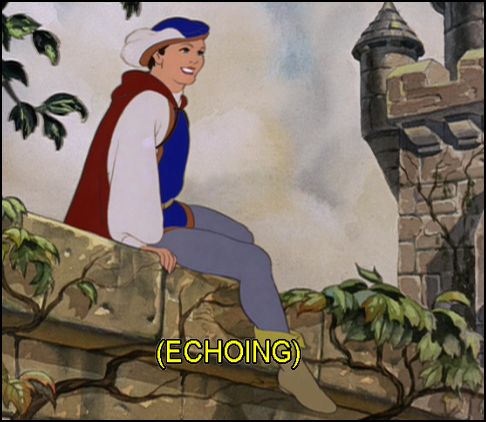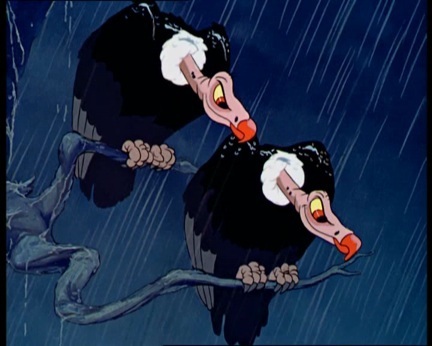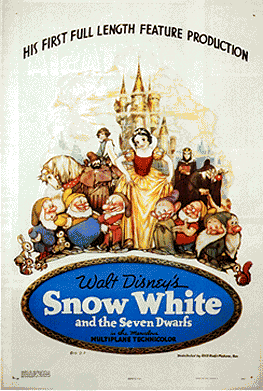Growing up, I loved all Disney movies, especially those involving princesses, but my great white whale was Snow White and the Seven Dwarfs. It hadn't been released in cinemas since 1987 (Mom decided not to take me, as I was two years old), it wasn't available anywhere on VHS and thus inaccessible. And back in the 1990s, kids, if something wasn't available on VHS, it wasn't available at all.
When I finally did see it, I liked it, but apparently not so much that I watched it ever again, so this is only my second time seeing it, by my reckoning. As Walt Disney's very first full-length animated picture and arguably the film that launched fifty more films just like it and the Walt Disney empire as we know it today. Should be interesting!
When I finally did see it, I liked it, but apparently not so much that I watched it ever again, so this is only my second time seeing it, by my reckoning. As Walt Disney's very first full-length animated picture and arguably the film that launched fifty more films just like it and the Walt Disney empire as we know it today. Should be interesting!
Background
Historical Context
1937 was a pretty dark year. Unemployment was beginning to drop, but the Great Depression was still on. The Hindenburg exploded, Amelia Earhart disappeared, the Mississippi and Ohio river flooded and destroyed thousands of homes, a dust storm swept Oklahoma, and ten union demonstrators were shot by police in Chicago. Hitler was busy plotting world domination in Germany, and Stalin was busy purging generals in the USSR. It was a good year for the arts, however: apart from Snow White, Death on the Nile, The Hobbit, and Of Mice and Men were published. The Golden Gate Bridge was also built. Still, one can't imagine that people were feeling very warm and fuzzy about the world that particular year--not too different from today, I imagine.
"Making Of" Notes
Of course, Snow White and the Seven Dwarfs was 36-year-old Walt Disney's first full-length animated picture, and is considered a pretty big deal culturally and historically. Previously, Disney had made his name with animated shorts, the kind that they showed before the main feature at the cinema. Here are some things I didn't know:
- Nobody thought it was a good idea, including Disney's brother and business partner, Roy, and his wife, Lillian, and the film was referred to as "Disney's Folly" while in production. Ha. Tell that to the Disney Princesses franchise now.
- The dwarfs were the main draw for Snow White as a fairy tale to adapt, because of their potential for "screwiness." The pool of about fifty potential names included Jumpy, Deafy, Dizzey, Hickey, Wheezy, Baldy, Gabby, Nifty, Sniffy, Swift, Lazy, Puffy, Stuffy, Tubby, Shorty and Burpy. One wonders what Hickey would have been like.
- The movie was originally envisioned as much more comical and slapstick, including a "fat, batty, cartoon type" for the Queen, and a somewhat more clownish Prince. I can't help but regret his metamorphosis from clownish to the blandest prince to serenade a Disney princess.
- The original plot was also a LOT more epic, as Wikipedia describes:
Creedon's eighteen-page outline of the story written from the October meetings, featured a continuous flow of gags as well as the Queen's attempt to kill Snow White with a poisoned comb, an element taken from the Grimms' original story. After persuading Snow White to use the comb, the disguised Queen would have escaped alive, but the dwarfs would have arrived in time to remove it. After the failure of the comb, the Queen was to have the Prince captured and taken to her dungeon, where she would have come to him (story sketches show this event both with the Queen and the Witch) and used magic to bring the dungeon's skeletons to life, making them dance for him and identifying one skeleton as 'Prince Oswald' (an example of the more humorous atmosphere of this original story treatment[6]). It is written in story notes that the Queen has such magical power only in her own domain, the castle. With the Prince refusing to marry her, the Queen leaves him to his death (one sketch shows the Prince trapped in a subterranean chamber filling with water[9]) as she makes her way to the dwarfs' cottage with the poisoned apple. The forest animals were to help the Prince escape the Queen's minions and find his horse. The Prince was to ride to the cottage to save Snow White, but took the wrong road (despite warnings from the forest animals and his horse, whom he, unlike Snow White, could not understand). He therefore would not have arrived in time to save her from the Queen, but would have been able to save her with love's first kiss. This plot was not used in the final film, though many sketches of the scene in the dungeon were made by Ferdinand Hovarth.
Which is a little disappointing, in light of the actual plot.
Animation
You can see both the Disney animators' inexperience with animating things like realistic people, but there's an artistic quality that we never see again. The backgrounds are gorgeous, with a watercolor quality.
You can see the difference between the scenes with the dwarfs and the scenes with the humans--the animators are clearly far more comfortable animating the cartoonish dwarfs and as a result, their scenes are visually more interesting.
I noticed a lot of future Bambi characters in the animal--I would be willing to bet that several of these cells will even be re-used. The animals aren't quite as beautifully drawn as in Bambi and are rather more cartoonish, but their movements are already spot on, something which Disney will continue to excel in right up to The Lion King. Disney does animals best.
Plot
Reading the originally planned plot made the one they put in place a little disappointing. It sticks pretty religiously to the original story, with many fewer additions compared to later Disney fairy tales, and in fact with a few subtractions. Unlike the original Grimm fairy tale, the Queen gets her on the first try with the apple, instead of having to try ribbons and combs first.
In fact, most of the screen time is taken up by Snow White singing and a series of comical sketches featuring the Dwarfs--coming home and discovering that the house has been cleaned, meeting Snow White, washing up for dinner. These comic shorts were clearly more of a comfort zone for Disney animators than, say, elaborate love scenes between two humans, and I suppose from Disney's success with Mickey Mouse shorts, he knew that the audiences liked them, too.
Characters
The Princess - As I said, I wasn't able to watch Snow White when I was very little. But we did locate an old record soundtrack, so we put it on, to my great excitement. But when Snow White's voice came on, I was horrified. "The record's broken!" I insisted. My mom said it wasn't. "But she sounds like a chipmunk!" I wailed.
Turns out--she DOES sound like a chipmunk, though the operatic quality of her voice and the fact that that style of singing with the hyper-vibrato was all the rage in 1930s. It turns out that Adriana Caselotti, age 18, was chosen because she had opera training but could still sound like a little girl.
Disney clearly had a very young girl in mind--her line delivery, gestures, and tone, which often reminded me of Shirley Temple. We hope that her youth explains her extreme naiveté: when you let an demonic-looking hag into your house (despite knowing that your evil stepmother is out for your blood), and then are persuaded into eating a suspiciously red apple by being told that it's a "wishing apple," you're either very sheltered or not very bright.
I'm going to uncharitably go with the latter and inaugurate our new Princess Superlatives by crowning Snow White "Dumbest Princess."
Other interesting tidbits:
- How she isn't nearly as absurdly skinny as later princesses. Her elbows, face, shoulders, and wrists are round and curvy, sometimes her chin disappears altogether, and even her waist, while decidedly slender, isn't as exaggeratedly tiny as Ariel's and Jasmine's, for example. But this probably shouldn't be surprising, again considering the beauty standards of the time
- Snow White speaks in rhyming couplets for the first half of the movie, briefly switches to more natural conversation with the Dwarfs when they find her in bed (!!), and then switches back to couplets at a later point. I'm not sure why they had her speak in couplets. Was it because the film was geared towards children?
- Her movements are that of a dancer in a ballet, especially when running away in the woods (it turns out that the body model for Snow White--they used a rotoscope--was a dancer named Marge Champion). The whole movie, in fact, has a ballet-like feel, right up to when we meet the dwarfs: short scenes dominated by music with very little dialogue. If you turned off the sound and turned on Tchaikovsky, I bet it would still make sense.
 |
| "Creepy," commented R. |
The Prince - No name, no personality, and only shows up when he absolutely has to. This unnamed prince the most boring love interest in any Disney film made. I began to wish that they had kept all that exciting sounding footage of the Prince being imprisoned in the Queen's dungeon watching skeletons dance, but it turns out (thanks, audio commentary!) that however hard a time the animators had with animating Snow White (only animals and very cartoonish people had ever been animated before), the Prince was very difficult. Walt Disney acknowledged that that was why we see the Prince so little, and he regretted not having a few extra years of experience before they tackled that particular project.
R commented that he was just being downright creepy when sneaking up behind Snow White at the well. Too bad, because that's pretty much all he does!
 The Villain - The villain in this movie is practically two entirely different characters. First there's the stately, evil Queen who looks a little like Katharine Hepburn and who is not particularly scary, though I wouldn't necessarily want her as my stepmother. But then there's the deranged, cackling Witch, who was utterly terrifying. She's accompanied by two truly evil-looking vultures to Snow White's house--at first we think that the vultures are her minions or sidekicks or something who are hoping to eat Snow White, but then they seem perfectly happy to eat the dead Queen instead. Very dark, and one of the scarier things that Walt Disney ever animated. No wonder children reportedly wet the seats in movie theaters all over the country.
The Villain - The villain in this movie is practically two entirely different characters. First there's the stately, evil Queen who looks a little like Katharine Hepburn and who is not particularly scary, though I wouldn't necessarily want her as my stepmother. But then there's the deranged, cackling Witch, who was utterly terrifying. She's accompanied by two truly evil-looking vultures to Snow White's house--at first we think that the vultures are her minions or sidekicks or something who are hoping to eat Snow White, but then they seem perfectly happy to eat the dead Queen instead. Very dark, and one of the scarier things that Walt Disney ever animated. No wonder children reportedly wet the seats in movie theaters all over the country.
Scary Scale: I would put her at a solid 9. I may be wrong (we'll see), but in Witch form, I think she's probably one of the scariest Disney villains to grace the silver screen.
 |
| Disney paid $5 for this "gag." |
The Sidekicks - Did you know that "dwarves" as a plural was only made commonplace by Tolkien using it in the Hobbit? So dwarfs it is in Snow White.
Originally the dwarfs were supposed to be the central characters, and you can really tell, as we spend about as much time with them as we do with Snow White. Grumpy's kind of a hick and talks like a character from Li'l Abner, complete with hayseed between his teeth. Riccardo pointed out that of course Happy is the fattest one. Doc is more obnoxious than I remembered, with a Porky Pig-esque stammer. And despite the fact that he was a big fan favorite, I found Dopey more than a little creepy this time around--what is wrong with him? Is he supposed to be childlike? Then why does he keep trying to cop a kiss on the mouth from Snow White? Is he just developmentally delayed? On something? Now I just found out that Dopey was originally "Deafy." Even worse!
R says, "Sleepy should be called Dopey, as he's clearly on drugs."
| My poodle does that too! |
The Animals - I'm pretty sure that not a single Disney movie has been made without animals as characters (we shall see!) but unusually, perhaps uniquely, this is a Disney movie where none of the animals talk. Or rather, only Snow White can understand them and the audience cannot.
They're beautifully drawn, however, and each one has its own personality. I can't help but marvel at the animators who got so many different animals moving in so many different ways in the same frames. I'm imagining a bunch of 20-something animators knocking back cigarette and coffee after cigarette and coffee all night long.
Music
Snow White has about three famous songs and many forgettable ones: "I'm Wishing / One Song," "With a Smile and a Song," "Bluddle-Uddle-Um Dum (The Dwarfs' Washing Song)," "The Silly Song (Dwarfs' Yodel Song)" being the more forgettable ones.
Something which really caught my attention this time was the didactic aspects to the plot. In "Whistle While You Work," Snow White is teaching the children (let's face it: the little girls) watching how to properly clean the house. "Uh uh uh! Not under the rug!" she scolds the squirrels at 1:00 who are trying to sweep the dust under the carpet (because the poor mouse's home is clearly a much better place). The fawn is also scolded for licking the plates clean. Later, in the Dwarfs' Washing Song, Doc teaches the other Dwarfs and the children watching (or rather, the little boys) how to wash up for dinner properly.
I was also charmed by how Disney used the music as sound effects. In "Whistle While You Work," they happen all over the place--the sounds of the deer's hoofs as he's tripping, the turtle giggling while getting washed on, the birds hanging up the wash. Animation and music blend together seamlessly and beautifully.
Most Memorable Song
"Some Day My Prince Will Come" has been covered scores of times by other artists (though rarely in Adriana Caseotti's original key...) and is generally known as the most iconic song of the movie and of Disney itself. However, I'm going to go with the less obvious but more pervasive and memorable song: "Heigh Ho."
Runner up:
Okay, we'll give "Some Day My Prince Will Come" a nod, too. It pretty much sums up everything feminists claim to hate about Disney, anyway.
Reviews
"Sheer fantasy, delightful, gay, and altogether captivating, touched the screen yesterday when Walt Disney's long-awaited feature-length cartoon of the Grimm fairy tale, Snow White and the Seven Dwarfs, had its local premiere at the Radio City Music Hall. [...] You'll not, most of the time, realize you are watching animated cartoons. And if you do, it will be only with a sense of amazement. [...] If you miss it, you'll be missing one of the ten best pictures of 1938. Thank you very much, Mr. Disney, and come again soon."
"There has never been anything in the theatre quite like Walt Disney's "Snow White and the Seven Dwarfs," seven reels of animated cartoon in Technicolor, unfolding an absorbingly interesting and, at times, thrilling entertainment. So perfect is the illusion, so tender the romance and fantasy, so emotional are certain portions when the acting of the characters strikes a depth comparable to the sincerity of human players, that the film approaches real greatness. It is an inspired and inspiring work, the commercial success of which will be notable, particularly the heavy foreign returns because of the mechanical ease with which all languages may be synchronized to the action."
It's easy for us of the 21st century to forget what a massive suspension of disbelief it takes to watch and believe in animated stories. A lot of reviewers, producers, and moviemakers of the time really weren't sure that the audience would believe in Snow White and care about her until the film was out. Think about it--they're just drawings, anyway. But it turns out that people are as capable of falling in love with an animated figure as they are a real one, and a genre was born.
The Boyfriend's Review:
The Boyfriend says: Inferiority complex, breaking and entering, and Stockholm's Syndrome.
What We Would Be Watching If I Hadn't Hijacked The Netflix Queue:
Another animated movie, actually, this time by Miyazaki rather than Disney--"Ponyo."
That's all for Snow White. Next up--Pinocchio!

